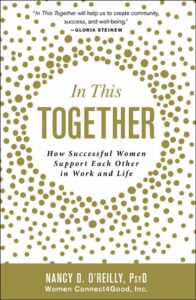 For women to be equal to men, we must think equal, which means we need to engage our male allies, and make them an equal part of the equality solution. Unfortunately, eighteen months after the rise of the #MeToo movement, a new study by LeanIn.org has found that 60 percent of male managers said they are uncomfortable interacting with women at work and are afraid to have a one-on-one meetings – up 32 percent from 2018. Senior men who were surveyed are also nine times more likely to avoid traveling with a woman and six times more likely to hesitate to have a work dinner.
For women to be equal to men, we must think equal, which means we need to engage our male allies, and make them an equal part of the equality solution. Unfortunately, eighteen months after the rise of the #MeToo movement, a new study by LeanIn.org has found that 60 percent of male managers said they are uncomfortable interacting with women at work and are afraid to have a one-on-one meetings – up 32 percent from 2018. Senior men who were surveyed are also nine times more likely to avoid traveling with a woman and six times more likely to hesitate to have a work dinner.
This is not good. Overwhelmingly men still hold positions of power at work, and this lack of access and potential mentorship can have devastating consequences on a woman’s career trajectory and gender equality as a whole. Rachel Thomas, president of LeanIn.org said that, “If men want to be part of the solution, then pulling away from women is the wrong thing to do.”
Sheryl Sandberg, Lean In’s founder and Facebook’s chief operating officer, recently said on CBS This Morning, “How do you get promoted without a one-on-one meeting?” You don’t. No one does.
“If there’s a man out there who doesn’t want to have a work dinner with a woman, my message is simple: Don’t have one with a man. Group lunches for everyone. Make it explicit, make it thoughtful, make it equal,” Sandberg said. “Men need to step up. We need to redefine what it means to be a good guy at work. It’s not enough to not harass, and I think too many people think that’s sufficient. That’s necessary, that’s a basic, but it’s not sufficient.”
With so few women in the C-suite and upper management, many women say their best mentors and allies have been men. As we wrote in the new book, In This Together, women employed in majority-male workplaces are already more likely to say that their gender has made it harder for them to get ahead at work. They are also less likely to say that women there are treated fairly in personnel matters, and they report experiencing gender discrimination at significantly higher rates. Disappointingly, nearly a third of women who work in mostly female workplaces say the same. These new findings, and increasing lack of access, makes a bad situation worse.
While women are leading the charge in the fight for equality at work, we cannot achieve parity without the support of men allies. All efforts to involve men in eliminating gender inequality, from historical women’s struggles, like suffrage, to sticking their necks out to support women at work today, hinges on one single strategy: communication, but we can’t communicate if we can’t get a meeting.
Catalyst reported that men’s support for gender equality can be engaged by appealing to their sense of fairness. In addition, shifting away from a win-or-lose mentality to recognizing that everyone benefits from gender equality can lead men to become greater advocates who endorse our efforts to change unfair practices.
We need equal access. We need to communicate our needs and goals and discuss ways to overcome gender bias, assumptions, and oppressive patterns of behavior at work. We need to point out the negative consequences of a lack of access and explain the ways that withdrawal severely limits women’s opportunities for advancement. Most of all, we need to highlight the thousands of ways we all win (men and women) when we achieve equality. Let’s not shy away from the steps we need to take to achieve gender equality in the workplace. The first step needs to be making men allies and an equal part of the solution. Let’s work together to make parity the norm.
Order Dr. Nancy’s New Book Today!
 Dealing with sexism and cultivating men as allies are just a couple of the issues covered in Dr. Nancy’s new book, In This Together: How Successful Women Support Each Other In Work and Life, along with thoughts, inspiration, and stories from 40 successful women.
Dealing with sexism and cultivating men as allies are just a couple of the issues covered in Dr. Nancy’s new book, In This Together: How Successful Women Support Each Other In Work and Life, along with thoughts, inspiration, and stories from 40 successful women.
Order your copy – and gifts for your friends today!

